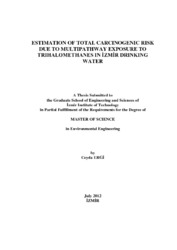Please use this identifier to cite or link to this item:
https://hdl.handle.net/11147/3474Full metadata record
| DC Field | Value | Language |
|---|---|---|
| dc.contributor.advisor | Sofuoğlu, Sait Cemil | en |
| dc.contributor.advisor | Tokatlı, Figen | en |
| dc.contributor.author | Ergi, Ceyda | - |
| dc.date.accessioned | 2014-07-22T13:51:37Z | - |
| dc.date.available | 2014-07-22T13:51:37Z | - |
| dc.date.issued | 2012 | en |
| dc.identifier.uri | http://hdl.handle.net/11147/3474 | - |
| dc.description | Thesis (Master)--Izmir Institute of Technology, Environmental Engineering, Izmir, 2012 | en |
| dc.description | Includes bibliographical references (leaves: 53-55) | en |
| dc.description | Text in English; Abstract: Turkish and English | en |
| dc.description | xi, 55 leaves | en |
| dc.description.abstract | The goal of this study was to investigate the cumulative and total carcinogenic risk levels of trihalomethanes (THMs) in İzmir drinking water by considering multi exposure routes and pathways. Drinking water THM concentrations measured and questionnaire data collected by Kavcar (Assessment of Exposure and Risk Associated with Trihalomethanes and Other Volatile Organic Compounds in Drinking Water, MSc Thesis, İYTE, 2005) were used for the exposure – risk assessment. Ingestion of drinking water, inhalation and dermal absorption during showering, bathing, hand washing, and dish washing were the considered exposure pathways. THM concentrations in air were estimated by using chemical specific transfer efficiencies. Chemical specific skin permeability coefficients and body surface areas were used . The contributions of exposure routes to the total risk, in the order of low to high, were dermal absorption, ingestion, and inhalation. Cumulative and total cancer risks were estimated using two different methods: commonly employed simple addition method and recently proposed Cumulative Relative Potency Factors (CRPF) approach. The total carcinogenic risks estimated by the both methods were acceptable (<1×10-6) in the minimum and lower bound exposure scenarios, generally acceptable (1×10-6 - 1×10-4) in the central tendency exposure scenario, and not acceptable (>1×10-4) in the upper bound and maximum exposure scenarios while simple addition produced an order magnitude higher risk levels compared to the CRPF method. The results of this study show that carcinogenic risks may be overestimated by using simple addition method. Nevertheless, risk mitigation measures are needed by the local water authorities. | en |
| dc.language.iso | en | en_US |
| dc.publisher | Izmir Institute of Technology | en |
| dc.rights | info:eu-repo/semantics/openAccess | en_US |
| dc.subject.lcsh | Trihalomethanes--Analysis | en |
| dc.subject.lcsh | Trihalomethanes--Environmental aspects | en |
| dc.subject.lcsh | Health risk assessment | en |
| dc.subject.lcsh | Water--Purification--Disinfection | en |
| dc.title | Estimation of total carcinogenic risk due to multipathway exposure to trihalomethanes in Izmir drinking water | en_US |
| dc.type | Master Thesis | en_US |
| dc.institutionauthor | Ergi, Ceyda | - |
| dc.department | Thesis (Master)--İzmir Institute of Technology, Environmental Engineering | en_US |
| dc.relation.publicationcategory | Tez | en_US |
| item.languageiso639-1 | en | - |
| item.fulltext | With Fulltext | - |
| item.openairecristype | http://purl.org/coar/resource_type/c_18cf | - |
| item.openairetype | Master Thesis | - |
| item.grantfulltext | open | - |
| item.cerifentitytype | Publications | - |
| Appears in Collections: | Master Degree / Yüksek Lisans Tezleri Sürdürülebilir Yeşil Kampüs Koleksiyonu / Sustainable Green Campus Collection | |
Files in This Item:
| File | Description | Size | Format | |
|---|---|---|---|---|
| T001011.pdf | MasterThesis | 1 MB | Adobe PDF |  View/Open |
CORE Recommender
Page view(s)
146
checked on Jul 22, 2024
Download(s)
84
checked on Jul 22, 2024
Google ScholarTM
Check
Items in GCRIS Repository are protected by copyright, with all rights reserved, unless otherwise indicated.